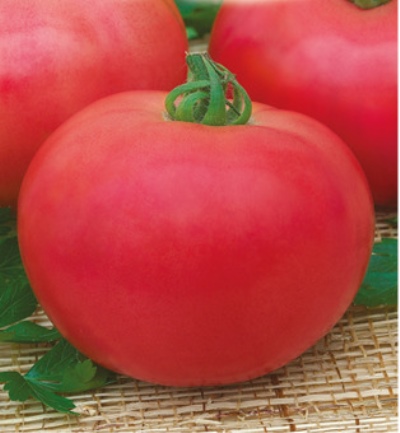
- Name synonyms: Andromeda Pink F1
- Category: hybrid
- Growth type: determinant
- Appointment: universal
- Ripening period: ultra early
- Ripening time, days: 80-87
- Growing conditions: for open ground, for film greenhouses
- Marketability: high
- Transportability: high
- Marketable fruit yield,%: 96
Early and productive varieties of tomatoes are the dream of every gardener. For small household plots, cultivation of hybrid varieties will be optimal, a bright representative of which is the ultra-early variety Andromeda pink.
Breeding history
This tomato variety was bred by a group of breeders led by Mashtakov in 1998. A few years later, this determinant tomato species was included in the State Register. Andromeda pink is zoned in the Lower Volga, East Siberian, Central Black Earth and North Caucasian regions.
Description of the variety
Variety Andromeda rosea are hybrid bushes, reaching a height of 60-70 cm. Under greenhouse conditions, they grow up to 100 cm. The bushes are semi-sprawling, with medium branching, the stems are powerful, but under the weight of tomatoes they can sag and even break. The root system of the variety is underdeveloped.
The main qualities of the fruit
Tomatoes are characterized by a regular flat-round shape and a beautiful pink color without a green spot at the base. The average weight of tomatoes is 90-120 grams. The skin is dense, smooth, with a glossy finish, does not allow the fruit to crack. An unripe tomato has a light green color, and when fully ripe, it evenly changes to a beautiful pink.
Taste characteristics
Andromeda pink tomatoes have excellent taste. The tomatoes taste sweet and sour, and the pulp is moderately dense, fleshy, with good juiciness and a small amount of seeds. The variety is universal, therefore it is good fresh, as well as processed. The small size of the fruits allows them to be preserved whole.
Ripening and fruiting
Early ripe variety. It takes 80-87 days to ripen. Tomatoes ripen evenly, do not crumble, despite the hybridity of the bush.
Yield
The yield of the variety is very good. With correct and consistent agricultural technology in the open field, up to 7 kg per 1 m2 can be harvested. In greenhouses, yields are slightly higher - up to 13 kg per 1 m2.
The timing of planting seedlings and planting in the ground
Sowing seeds for seedlings is carried out in the second half of March. It usually takes 60-65 days to grow seedlings. The first week, before the seeds grow, it is necessary to use oilcloth, and then it is removed. To grow healthy bushes of seedlings, you need warmth indoors (+ 20 ... 22 degrees) and constant lighting. As soon as 2-3 healthy true leaves have appeared, it is necessary to dive the bushes into separate containers. Before planting in the ground, hardening is carried out - a gradual decrease in the temperature in the room.
You can plant in open ground in mid-May, when the threat of night frosts is behind. At first, a film coating is recommended, and at the beginning of June, the seedlings are already comfortable in the open field without covering.

Growing tomato seedlings is an extremely important process, because it largely depends on whether the gardener will be able to harvest at all.All aspects must be taken into account, from seedbed preparation to planting in the ground.
Landing scheme
The planting density of the bushes is 4 units per 1 m2. The formation of a tomato is carried out in 2 stems. The planting scheme is as follows: 50x40 cm.

Growing and care
It is recommended to grow Andromeda pink tomatoes in areas with fertile soils, which are perfectly illuminated by the sun and are reliably protected from gusts of wind and drafts. As practice shows, the more sun, the more sugary the tomatoes. Before planting seedlings, you need to clear the area of weeds and other debris, dig it up well to ensure air permeability, saturate the soil with mineral fertilizers and prepare the holes. A support is required near each bush, since a garter is required.
Comprehensive care of the variety includes: watering with warm water, abundant feeding, pinching, garter, loosening and weeding.




A plant needs different micronutrients at each stage of growth. All fertilizers can be divided into two groups: mineral and organic. Folk remedies are often used: iodine, yeast, bird droppings, eggshells.
It is important to observe the rate and period of feeding. This also applies to folk remedies and organic fertilizers.
Disease and pest resistance
The immunity of the seed crop is quite high. Tomatoes manage to harvest before late blight occurs, but preventive measures should not be ignored. They are resistant to tobacco mosaic virus, cladosporiosis, fusarium wilt and verticillosis. In order to avoid the appearance of diseases and viruses, it is necessary to strengthen the immune system of the plant - to feed it with potassium and phosphorus.


Resistant to adverse weather conditions
The variety is absolutely unpretentious and perfectly tolerates different climatic conditions. In regions with a warm climate, the crop is grown in open ground, and in the northern regions - in greenhouses. In addition, the variety tolerates heat well.
Growing regions
Tomatoes are grown in all climatic zones. Recently, they have been massively growing not only in Russia, but also on the territory of Ukraine and Belarus.
Review overview
Andromeda pink tomatoes are a favorite variety of many summer residents and farmers, since the culture is unpretentious in care, gives abundant and tasty yields, despite its hybridity, and is also resistant to many diseases and pest infestations. In addition, the variety quickly adapts to the soil, is early maturing and can withstand transportation without great losses.

























































































